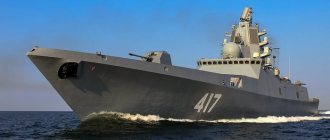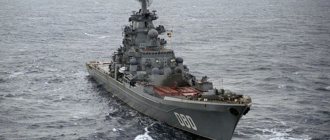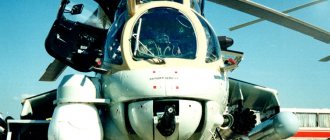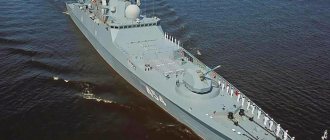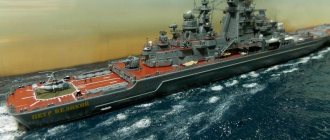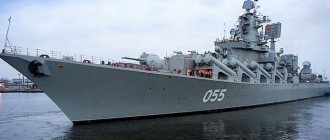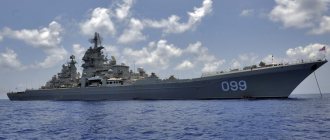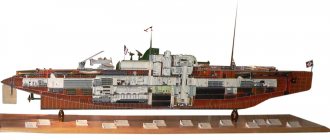The landing of amphibious assault forces on coastal beachheads with the aim of capturing them is a very important and frequently encountered method of conducting modern combat operations. One of the most important requirements for an amphibious landing is the speed with which the paratroopers, as well as military equipment, are able to land on the shore. Speed means surprise, the ability to take the enemy by surprise, and the ability to develop further success of an offensive operation; this is the key to victory.
However, such an advantage can only be achievable in cases where modern armed forces have high-speed sea vehicles to deliver amphibious assault forces, as well as military equipment, to the place where the landing is to take place. Do modern Russian armed forces have such capabilities? Yes, there are. Modern Russian marines disembark from Serna-class landing boats. However, recently, military equipment has been developing by leaps and bounds, and therefore the Serna boats are outdated both technically and morally. They should be replaced by transport-landing boats of a new type and new technical capabilities. The creation of such boats was named project 21820 and code “Dugong”.
Brief information about the company that builds Project 21820 boats
The project includes the construction of new small landing craft, the operating zones of which should be coastal sea waters, as well as rivers.
The project is being developed by the Russian enterprise Alekseev Pulp and Paper Mill. Today it is the only production and design center in the world that creates hydrofoil ships. There are several other enterprises in the world that are trying to build the same ships, but their products cannot be compared with those produced by the Russian enterprise. Back in the middle of the last century, the famous giant ekranoplane, nicknamed the “Caspian Monster,” was designed and built here. Over the entire period of its existence, the company has designed and put into operation about 9 thousand hydrofoils. These were both warships and civilian vessels.
Information about project 21820 "Dugong"
The new landing craft of Project 21820 “Cipher” will be built on the basis of the previous domestic version of the “Serna”. For the Project 21820 boat, all the best from the Serna was taken, plus the latest technical developments were added to it. As a result, according to the designers’ plans, the result should be a vessel that has no equal in the world today.
The bottom is equipped with a so-called air cavity. Such a hydrodynamic device is not new, but until recently it existed exclusively in theoretical developments. Thanks to this technical innovation, landing craft will have a much greater carrying capacity, while maintaining their small size and without losing speed. Moreover, thanks to this technical innovation, boats will be able to move much faster, and, in addition, their engines will be able to operate much more economically.
The displacement of the new type of landing boats will be significantly greater than that of their previous generation counterparts. In addition, they will have greater capacity and carrying capacity. The speed will also be higher, as already mentioned. Another important innovation is that the ships will be invisible to enemy radars. There are supposed to be serious weapons on board. In particular, they will be armed with two heavy machine guns, as well as the Igla portable anti-aircraft missile system.
Thanks to these characteristics, the boat will be able to successfully deliver paratroopers to the shore. In addition, it will be able to cover paratroopers in the event of an attack from the sea or from the air. Another advantage is that during the landing he, thanks to his weapons, will be able to support them with fire.
Landing craft
The landing craft is the younger brother of a combat ship (UDC), designed to transport military equipment and drop off amphibious assault forces. It is so convenient that it is part of the main fleets of the world. Its history of creation is connected with the fact that in the First World War, ships could hardly approach unequipped shores for the transfer of personnel and weapons. Therefore, after the war, representatives of the fleet began to think about creating special watercraft that could deliver combat cargo and soldiers to the shore without a pier or other means necessary for berthing. So in the late 1930s, British designers designed a combat boat of the MLC type. Subsequently, the spread of the boat to other countries changed its name. In Germany it was called a sea landing barge. Britain designated it as a mechanized landing craft, and in the United States the boat was called an auxiliary landing craft. This did not change the essence of the floating craft. Already by the beginning of the Second World War, almost all the main participating countries had a boat of this type in their fleets. For the Soviet Union, the project became possible only in the post-war years.
Landing craft type LCM 6 (USA)
Landing capabilities
The reinforced hull, shallow draft and flat bottom of the boat make it possible to refloat without any help. It is relatively small in size and quite mobile. Due to its characteristics, it can easily approach the very shore in shallow water or swim into hard-to-reach places on the coast, for example, hidden beaches or coves. This allows you to land amphibious assault groups and weapons without giving away your location.
Mobile ships can transport 1-2 tanks or up to 7 armored vehicles. Or it can carry up to 200 armed Marines.
Stages of construction of boats of project 21820
As usual, the firstborn of Project 21820 was built first, it was called “Ataman Platov”. The vessel was laid down in 2006. Four years later it became a combat unit of the Caspian Flotilla. Then they began construction of two more new ships. One boat was built by the Vladivostok shipbuilding enterprise Vostochnaya Verf, and the other by the Nizhny Novgorod shipbuilding enterprise. In addition, in 2011, the Russian Ministry of Defense decided to begin construction of three more boats, concluding a contract with the Yaroslavl Shipyard for this purpose.
Exactly how many Project 21820 ships will eventually be built is unknown to the general public. But it is known that all built and future boats will be named after the heroes who participated in the Patriotic War of 1812. Thus, the boats built in Yaroslavl were named “Denis Davydov”, as well as “Michman Lermontov” and “Lieutenant Rimsky-Korsakov”. The last two heroes are Russian sailors who took part in battles with the French on land in 1812.
In 2014, the construction of two boats from Project 21820 was completed. One of them, Denis Davydov, joined the Baltic Fleet, and the other, Ivan Kartsov, was assigned to the Pacific Fleet. After them, “Michman Lermontov” and “Lieutenant Rimsky-Korsakov”, built by shipbuilders from Yaroslavl, entered service. Both ships are also assigned to the Baltic Fleet. Based on initial reviews, all boats of Project 21820 “Cipher” are far superior to similar models of previous generations.
Service history
Landing during exercises
In 1991, 10 boats of this type joined the Black Sea Fleet. One boat (D-305, 1979) was transferred to the Ukrainian Navy in the early 1990s. In the list of ships of the Ukrainian Naval Forces, the dry cargo barge “Svatove” is listed. As of March 23, 2014, it is based in Ochakov.
As of 2015, the 100th brigade of landing ships of the Pacific Fleet, stationed in Fokino, still has three boats that are actively used during exercises when landing on training grounds. One of the boats annually participates in a theatrical show on Navy Day in Vladivostok, as a sea dragon.
Detailed technical parameters and tactical features of Project 21820 boats
The new Russian transport and landing boats have the following parameters and performance characteristics:
- Displacement – up to 280 tons;
- Maximum length – 45 meters;
- Maximum width – 8.5 meters;
- Draft depth – 1.9 meters;
- Travel speed – up to 35 knots;
- Can be used in a storm, if the wave does not exceed a height of more than 3.5 meters;
- The boats are equipped with two diesel engines;
- The total power of the two engines is 18,000 horsepower;
- The maximum cargo that can be taken on board is 140 tons. This allows for the placement of two modern tanks;
- The cargo compartments can accommodate three infantry fighting vehicles or the same number of armored personnel carriers;
- Crew – 6 people;
- Control - automobile type.
Thanks to the design features, the boats have the ability to successfully move in shallow water, and, moreover, in reservoirs where there is a lot of debris.
Universal landing ships of the USSR and Russia
The fleet included such unique ships as the Ivan Rogov-class BDK (project 1174), which until recently were the most advanced large landing ships of the Russian Navy.
BDK project 1174 "Ivan Rogov"
The BDK of the ocean zone of Project 1174 was intended for transportation and landing on both equipped and unequipped coasts with a low bottom slope of landing forces with military equipment. The landing of troops was carried out both directly on the shore and without approaching it: amphibious equipment - under its own power, non-floating equipment - with the help of landing craft, landing personnel with portable weapons - on four Ka-29 transport and combat helicopters capable of providing fire landing support.
To unload non-floating equipment without approaching the shore, six landing boats of Project 1785 or Project 1176 “Akula” or three landing hovercraft of Project 1206 “Kalmar” were accepted into the docking chamber. Each of the listed landing boats could transport one tank or other mobile equipment, depending from capacity.
The ship's total displacement was 14,000 tons. The ship could transport up to 440 paratroopers and 79 pieces of equipment (armored personnel carriers, infantry fighting vehicles, tanks, cars, etc.) or a tank unit with 46 main battle tanks. There was a tank hold in the bow of the ship, and a dock chamber in the stern.
Project 1176 “Shark” landing craft
The ship's armament included the OsaM self-defense anti-aircraft missile system (one launcher, 20 missiles), a two-gun 76.2 mm AK-726 artillery mount and four 30 mm AK-630 assault rifles. In addition, to engage coastal targets, the BDK is equipped with a Grad-M multiple rocket launcher.
The shape of the ship's hull contours ensured the achievement of a high (for a landing ship with a bow landing gear) full speed (21 knots) with good landing characteristics and practically unlimited seaworthiness. Three ships were built according to this project.
In the 80s last century, the Nevsky Design Bureau was developing a UDC helicopter carrier, project 11780. The fleet ordered two ships of this project - Kremenchug and Kherson. The collapse of the country prevented their appearance in the fleet.
With a displacement of about 25,000 tons, the Project 11780 UDC was supposed to carry up to 1,000 marine units, up to 30 helicopters and from two to four landing hovercraft or a larger number of smaller landing craft.
In its ideology, it repeated the American UDC of the Tarava type, however, Project 11780, which was dubbed “Ivan Tarava,” should also have a number of advantageous differences from Western ships. First of all, this concerned more powerful weapons, including medium-range air defense systems, and in a number of project options, the AK-130 artillery mount, which theoretically could increase its potential to support landings. The high speed - up to 30 knots - with appropriate aircraft armament made it possible to use Project 11780 as an anti-submarine ship.
What is the situation with universal landing ships in the Russian Navy?
Today, the Russian Navy has, at first glance, a fairly serious number of large landing ships - four Project 1171 ships with a total displacement of 4,650 tons, built from 1964 to 1975. in Kaliningrad, and 15 ships of Project 775 and its modifications (4,500 tons) - Polish-built. But some of them are 30–40 years old, the youngest, the Korolev landing ship, is 26 years old. Thus, almost all of these units, due to their physical and moral obsolescence, objectively require urgent replacement.
BDK project 775 "Korolev"
The most modern Russian large landing ships are Project 11711. The lead ship, the Ivan Gren, entered service with the Navy in 2022, the first production ship, the Pyotr Morgunov, is undergoing testing. It is expected to be accepted into the fleet this year, 2022.
From the very beginning, the ships of this project had no luck. The lead ship was laid down at the shipbuilding plant back in December 2004. However, the lack of timely funding led to the fact that soon the work on its construction was actually frozen and resumed only in 2008. The ship was launched in May 2012, but due to short delivery documentation and counterparty equipment, the deadline for order readiness was postponed more than once. As a result, the ship was completed for five years...
Initially, a series of six ships was planned, but the vacillation in the final decision on which Russian fleet needs a landing ship led either to conflicts with the Mistrals, which are designed according to civilian standards and a priori are not full-fledged warships, or to serious changes in the project. The concept of using the Project 11711 BDK was also subject to changes during construction; the project was adjusted in terms of changes in the composition of weapons, radio-electronic equipment and changes in performance characteristics. The protracted construction led to the fact that the desire to save money and reduce the construction time of the ship also played an important role. As a result, it was decided to reduce the series to just two units.
The advantages of a controversial, but undoubtedly unique project usually include the presence on board of two Ka-29 helicopters. At the same time, one should take into account the fact that both helicopters are located one behind the other - the design of the main hangar, designed for one helicopter, has a retractable part towards the helipad. With lengthy pre-flight preparation and post-flight maintenance, the simultaneous use of both machines is practically impossible. This is critical given the accepted tactics of attack helicopters, which typically attack ground targets in pairs.
Based on the results of testing and operation of these large landing ships, a decision was finally made to build two more ships of this type. In April 2022, during the groundbreaking ceremony for the third and fourth buildings, USC President Alexey Lvovich Rakhmanov announced that their construction would be carried out according to a modified project. The project code will not be adjusted in this case.
There are no landing helicopter carriers in the Russian Navy, although the question of the need for their presence has been repeatedly raised.
Without in any way trying to take on the role of adepts of military science, theorists, tacticians and strategists from the fleet, I would like to express a few personal general thoughts about what a promising landing ship of the Russian Navy sees in the future.
It is quite obvious that the fleet needs large landing ships with the functionality of the large landing craft of the Ivan Gren type, and ships of smaller displacement and landing craft and ekranoplanes, a new round of development of which will sooner or later occur.
But since today we are talking about recreating an ocean-going fleet capable of bearing the burden of one of the most important tools for solving Russia’s geopolitical problems, then it is necessary to move away from recreating, in one form or another, combat units that were adapted to the realities of the early 21st century, but nevertheless have already become classic . You should, having studied world experience and reworked it to suit your goals and objectives, think about the need to design and build a larger and more expensive “station wagon” - a relatively small “landing aircraft carrier” with very great capabilities.
Nowadays, various variations of self-propelled landing craft of the LCM type (landing craft mechanized) used by foreign fleets as landing craft are almost identical to those that landed troops on the Normandy coast on the famous D-Day. They are capable of delivering one main battle tank (MBT) or about 60 ... 80 marines ashore with a maximum speed of about 10 knots. Boats of the LCM-8 type (six of these boats are carried on board American UDCs of the America type) can carry one tank or up to 200 people. But the speed remains just as low.
The Russian "Chamois" (landing boat of Project 11770) look much more preferable against their background. "Serna" can transport one MBT, or two infantry fighting vehicles (or armored personnel carriers), or 92 troops at a speed of 27 knots with sea level 3. Landing boats of the Dugong type (project 21820) can also be considered to equip a promising landing aircraft carrier and qualitatively improve its transport and landing capabilities. The Dugong carries two main battle tanks or four infantry fighting vehicles/armored personnel carriers and reaches speeds of up to 35 knots.
Project 11770 landing craft "Serna"
It is also possible that the ship will use Project 02510 landing craft of the BK-16 type, intended for special forces during operations, including in the coastal sea zone. The BK-16 can deliver 19 troops to the coast at a speed of 40 knots. Such boats, of course, should not be the main landing craft, but be a useful addition to the above-mentioned Chamois and Dugongs.
Project 21820 landing craft of the Dugong type
As many experts note, speed in itself is not protection. At a sufficiently large distance, a target moving both frontally and flanking is equally well hit. But in our case - an amphibious landing with the capture of a bridgehead - the psychological factor, which in this case acts on both sides, and the reduction in the time period during which troops or supplies are transferred to the coast are more important.
High-speed transport and landing boat of project 02510 type BK-16
Also, LCAC (Landing Craft Air Cushion) hovercraft are widely used on foreign ships. They, like LCMs, take on board one MBT, but 180 marines, and “run” faster - the maximum speed (with a full load) is over 40 knots.
This is where the Russian fleet has a certain gap. Modern amphibious airborne aircraft suitable for basing on the promising UDC are simply not available yet. Certain work has been initiated towards the creation of such hovercraft for equipping the Mistrals. It is quite obvious that they must be brought to their logical conclusion with adaptation to promising ships of the considered class of Russian projects.
(End to follow)
The article was published in the October 2022 issue of the journal Science and Technology
Found a typo? Select a fragment and press Ctrl+Enter.
Tags: Fleet BDK Navy of the Soviet Union weapons UDC
Previous article Chinese Navy Shan-class attack submarines. Projects 093, 095
Next article What will the aircraft carrier of the future be like?
Provided by SendPulse
Likes 0
Did the first samples of Project 21820 live up to expectations?
This question can be answered unequivocally: the landing boats of Project 21820 were fully justified. Back in 2011, the first-born of the “Ataman Platov” series participated in combat exercises called “Center-2011”. The exercises were conducted in the Caspian Sea. At these exercises, “Ataman Platov” showed itself, as they say, in full glory. The boat successfully delivered the marines along with armored vehicles to the shore, demonstrating all its unique combat properties during the exercises.
Based on first impressions of the boats, today there is a strong opinion that they are doing a good job fulfilling the combat role that is intended for them, and therefore their construction will continue. Three Russian fleets – the Baltic, Pacific and Black Sea – will be equipped with new boats. During construction, they can be subject to changes and improvements in terms of their technical and combat characteristics.
Service history
"D-144" was built in 2007 at the Shipbuilding Plant in Nizhny Novgorod, and in the same year it was transferred to Novorossiysk for acceptance tests. The crew of this landing boat (5 people) was formed and trained at the Caspian Flotilla, where by that time there were already landing craft of this project. On February 19, 2008, the landing boat "D-144" raised the St. Andrew's flag and became part of the Black Sea Fleet of the Russian Federation.
As of January 2009, 4 boats of this project were in service with the Caspian Flotilla, one boat was in service with the Russian Black Sea Fleet, and another boat was in service with the Baltic Fleet.
On October 8, 2010, the new landing boat “D-107” code “Serna” was put at the disposal of the Pacific Fleet. The new boat will be part of a landing ship formation based in Strelok Bay. The D-107 landing craft was laid down at the Eastern Shipyard slipway in Vladivostok on December 11, 2008, launched on April 15, 2010, and the ship was presented for state testing on May 30, 2010.


